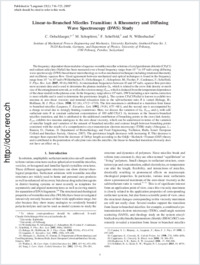Linear-to-branched micelles transition: a rheometry and diffusing wave spectroscopy (DWS) study
- Oelschlaeger, C. Institute of Mechanical Process Engineering and Mechanics, University Karlsruhe, Germany
- Schopferer, M. Institute of Mechanical Process Engineering and Mechanics, University Karlsruhe, Germany
- Scheffold, Frank Department of Physics, University of Fribourg, Switzerland
- Willenbacher, N. Institute of Mechanical Process Engineering and Mechanics, University Karlsruhe, Germany
-
16.12.2008
Published in:
- Langmuir. - 2009, vol. 25, no. 2, p. 716–723
English
The frequency-dependent shear modulus of aqueous wormlike micellar solutions of cetylpyridinium chloride (CPyCl) and sodium salicylate (NaSal) has been measured over a broad frequency range from 10⁻² to 10⁶ rad/s using diffusing wave spectroscopy (DWS) based tracer microrheology as well as mechanical techniques including rotational rheometry and oscillatory squeeze flow. Good agreement between mechanical and optical techniques is found in the frequency range from 10⁻¹ to 10⁵ rad/s (Willenbacher, N.; Oelschlaeger, C.; Schopferer, M.; Fischer, P.; Cardinaux, F.; Scheffold, F. Phys. Rev. Lett. 2007, 99 (6), 068302). At intermediate frequencies between 10 and 10⁴ rad/s, squeeze flow provides most accurate data and is used to determine the plateau modulus G₀, which is related to the cross-link density or mesh size of the entanglement network, as well as the scission energy Esciss, which is deduced from the temperature dependence of the shear moduli in the plateau zone. In the frequency range above 10⁴ rad/s, DWS including a new inertia correction is most reliable and is used to determine the persistence length lp. The system CPyCl/NaSal is known to exhibit two maxima in zero-shear viscosity and terminal relaxation time as the salt/surfactant ratio R is varied (Rehage, H.; Hoffman, H. J. Phys. Chem. 1988, 92 (16), 4712−4719). The first maximum is attributed to a transition from linear to branched micelles (Lequeux, F. Europhys. Lett. 1992, 19 (8), 675−681), and the second one is accompanied by a charge reversal due to strongly binding counterions. Here, we discuss the variation of G₀, Esciss, and lp with salt/surfactant ratio R at constant surfactant concentration of 100 mM CPyCl. G₀ increases at the linear-to-branched micelles transition, and this is attributed to the additional contribution of branching points to the cross-link density. Esciss exhibits two maxima analogous to the zero-shear viscosity, which can be understood in terms of the variation of micellar length and variation of the amount of branched micelles and contour length between branching points consistent with the results of a comprehensive cryo-transmission electron microscopy (TEM) study (Abezgauz, L.; Ramon, O.; Danino, D. Department of Biotechnology and Food Engineering, Technion, Haifa, Israel. European Colloid and Interface Society, Geneva, 2007). The persistence length decreases with increasing R. This decrease is stronger than expected from the decrease of Debye length according to the Odijk−Skolnick−Fixman (OSF) theory and is attributed to the penetration of salicylate ions into the micelles; the linear-to-branched transition obviously does not have an effect on lp.
- Faculty
- Faculté des sciences et de médecine
- Department
- Département de Physique
- Language
-
- English
- Classification
- Physics
- License
-
License undefined
- Identifiers
-
- RERO DOC 11893
- DOI 10.1021/la802323x
- Persistent URL
- https://folia.unifr.ch/unifr/documents/301113
Statistics
Document views: 108
File downloads:
- pdf: 257
